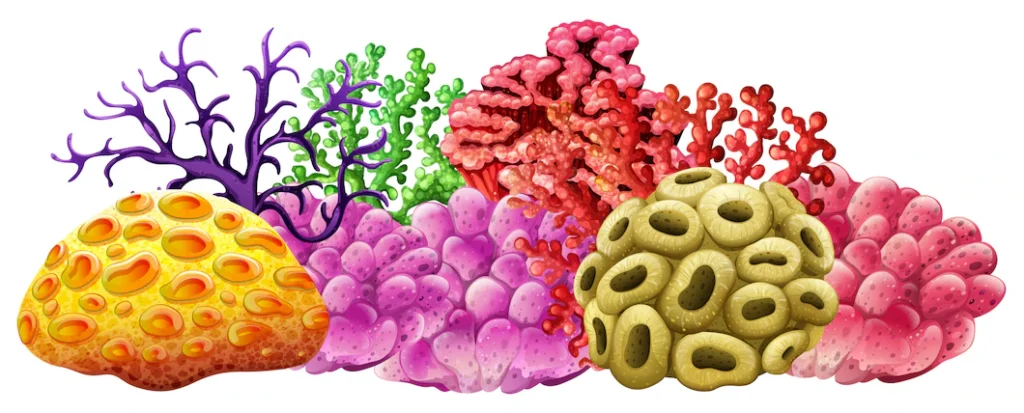Coral reefs offer an essential source of income for millions of people and safeguard coastal regions by lowering the force with which waves crash onto the shoreline. They are a vital ecosystem component that supports life in the ocean.
Coral reefs are home to an astonishing variety of marine life. There may be as many as a thousand different species on a single reef. Approximately 400 types of coral, 1,500 species of fish, 4,000 species of mollusks, and six of the world’s seven sea turtles may be found on the Great Barrier Reef. The Coral Triangle is the most ecologically diversified marine environment on Earth and is located in Southeast Asia. This coral-rich maritime area in Southeast Asia comprises the seas between Indonesia, Malaysia, the Philippines, and Papua New Guinea.
Coral reefs are estimated to have a worldwide worth of £6 trillion annually. This value is partially attributable to their benefits to the fishing, tourist, and coastal protection sectors.
Reefs are essential to more than 500 million people throughout the globe because they provide food, work, and coastal protection. They contribute to protecting regions such as mangrove forests and seagrass beds, which serve as nurseries for marine species and human populations who live along the shore. Ridges in coral reefs function as barriers and may limit the energy of waves by up to 97%, offering a basic level of protection against dangers such as tsunamis.
Researchers have used extracts from the animals and plants that live on reefs to find medicines for conditions such as asthma, arthritis, cancer, and heart disease.
Understanding coral reef connectivity is essential to focus conservation efforts.
Local fisheries and the biodiversity associated with them both benefit from the transfer of larvae across reefs, with some reefs benefiting more than others. As a result, proposals have been made to safeguard the connection of larvae among coral reefs.
Researchers found a severe lack of marine protected areas (MPAs) and other effective area-based conservation measures (OECMs) on coral reefs, as well as chances to fill those gaps and take advantage of those opportunities.
The results point to fundamental disparities in the relevance of different elements of coral reefs’ connectivity when compared to their involvement in preserving biodiversity and providing support for local fisheries.
According to studies conducted worldwide, reefs that are recipients of larvae from highly linked corridors of larval dispersion are home to a wider variety of fish species. Reefs are predominantly used as “sinks” for larvae; reefs that larvae arrive to after traveling on ocean currents contain almost twice as much biomass as reefs used as “sources” for larvae reefs that are used to produce nymphs. These sand reefs are more resistant to the effects of human pressure when they are protected. It is possible to make an educated decision regarding the placement of marine protected areas and other ocean ecosystem connectivity features (MPAs and OECMs) by first determining the distinct yet complementary roles that sink sources and dispersal corridors play in the provision of ecosystem services (as measured by the number of fish species and their biomass). This will allow for the most effective maintenance of biodiversity and the most significant possible benefit to fisheries.
Scientists have known for decades that larval connectivity is essential for maintaining fish and invertebrate populations in the ocean. However, this study demonstrates that the effectiveness of a conservation area can be influenced by whether a reef is a sink, source, or corridor for larvae.

Bringing to light relationships
Ocean biophysical models were used to estimate the spread of fish larvae throughout coral reefs all over the globe. These models considered both ocean currents’ movement and larvae’ biological properties. The first work was to mimic coral reef larval connection at this geographic scale and detail for four different fish groups with diverse life histories. This work was the first to model coral reef larval contact, even though similar techniques have been extensively employed in marine ecology and conservation.
On coral reefs, different fish species may contribute to various ecosystem services. For instance, large, predatory fish with a relatively short spawning season may substantially contribute to local fisheries. On the other hand, small reef fishes that reproduce more frequently throughout the year are responsible for much of the stunning fish diversity we observe on healthy coral reefs. When it comes to the maintenance of ecosystem services, understanding the role that various species’ larval connection patterns play may give insights into the appropriate design of protected areas depending on the conservation and sustainability objectives they aim to achieve.
One of the innovative aspects of this research is that it combines geographical information on larval dispersion networks with degrees of human pressure to examine the significance of human pressure levels about the value of connectivity features for sustaining ecosystem services. The findings of this study lend credence to the idea that larval source-sink networks are critical to the sustainability of local fisheries.
Strategies for reef conservation are influenced by reef connectivity.
On the other hand, the findings of this latest study show that the more significant potential of larval sinks to contribute to local fisheries differs depending on the management level and the amount of pressure exerted by humans. However, fishing regulations are still required to maintain the role these areas play in delivering fisheries advantages to local coastal communities. Locating larval sinks may be beneficial in identifying OECMs’ “sweet spots” targeted at local fisheries subsistence.
Despite their significance, only 30% of the coral reefs determined by this research to be functionally essential for preserving biodiversity and fisheries are now protected. This study proposes a science-based, policy-relevant framework that incorporates coral reef connectivity characteristics in the strategic placement of future marine protected areas to address the current gap and provide insight into the proposed expansion of marine protected areas and other ocean-based conservation measures by the year 2030.
Conclusion
Because of the projected widespread deterioration of reef ecosystems brought on by climate change, strategic planning and restoration efforts that are helped by technology are necessary to assure the continued existence of coral reefs. If steps are not scalable in space and time, the money invested in coral reef restoration won’t be enough to fix the problem. The use of remote sensing may be an effective means of contributing to achieving reef restoration goals. Although remote sensing may not give the same amount of fine-level data as a field survey, it can uncover trends on both big and small scales.
The current demands include improving coral spectrum remote sensing databases, discovering the essential landscape and animal interactions, species-specific acoustic signals, and enhanced integration of different remote sensing methods. While it is still necessary to address the underlying causes of reef devastation, such as climate change, overfishing, and pollution, using restoration strategies informed by geospatial data will increase the likelihood that coral reef ecosystems will be preserved well into the foreseeable future.
- About the Author
- Latest Posts
A passionate advocate for all natural and sustainable ideas. With a background in sustainable economics science and a deep love for nature, Sojy has dedicated his career to promoting eco-friendly practices and encouraging others to live a more sustainable lifestyle. He is an avid hiker, gardener, and cook, and loves experimenting with natural ingredients in his recipes and lifestyle routines. Sojy believes that small changes can make a big impact and is constantly seeking out new ways to reduce his carbon footprint and inspire others to do the same



